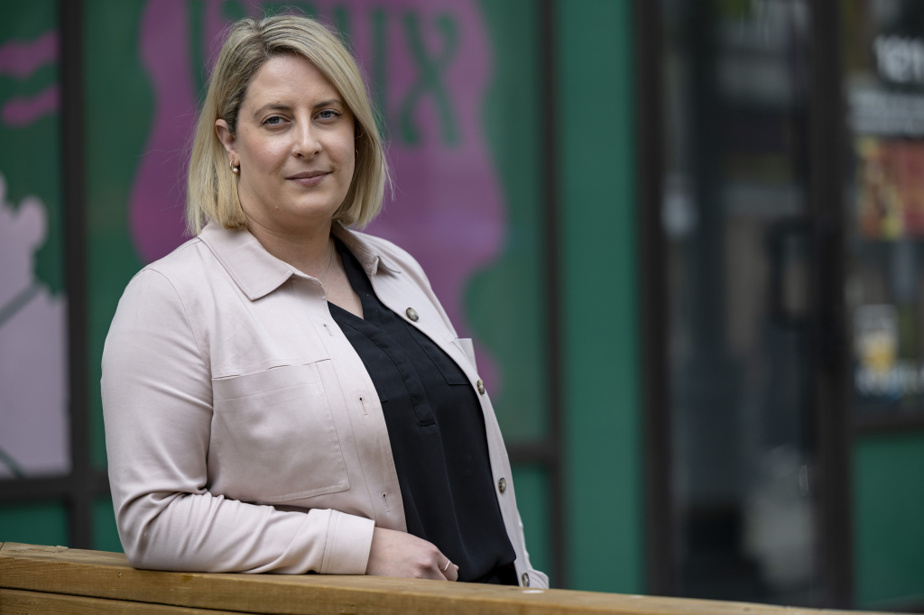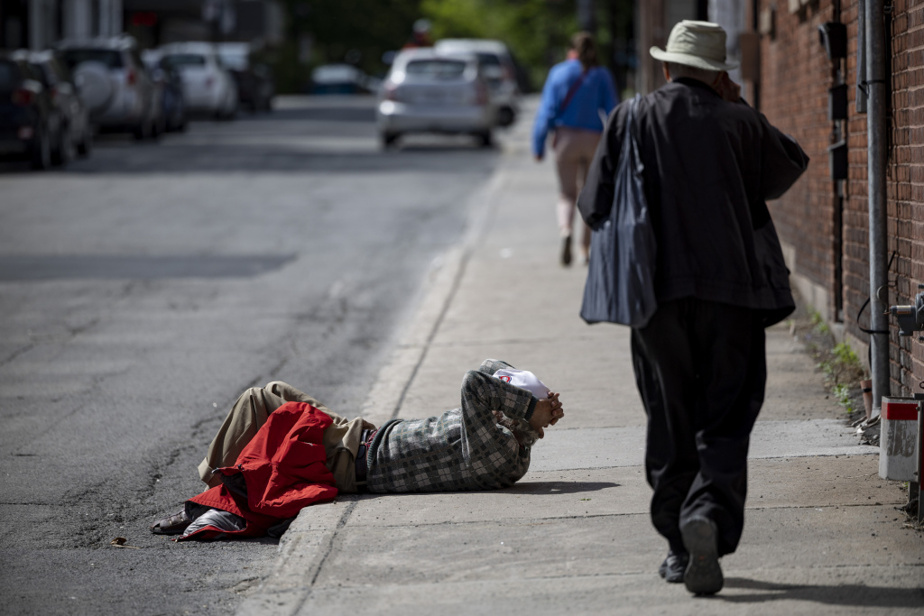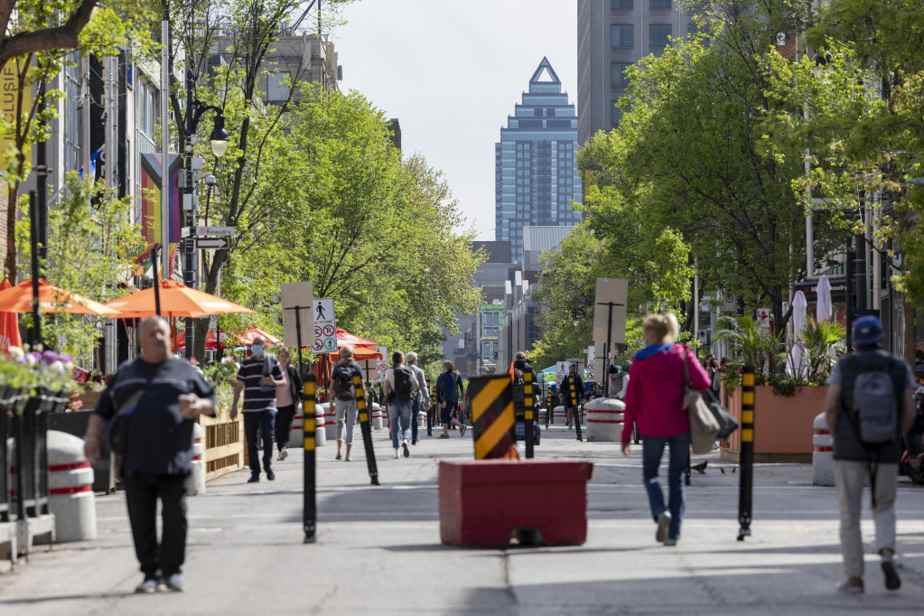Posted at 5:00 a.m.
A neighborhood in search of its breath
On a June evening, on the terraces with colorful umbrellas in the Village, customers of bars and restaurants are enjoying the mild weather while sipping their beer. The atmosphere is festive. Meanwhile, not far away, a homeless man sets up his sleeping bag for the night in the entrance of a closed business. In a small park, near the metro, two individuals argue. Passers-by roam rue Sainte-Catherine, reserved for pedestrians, without paying attention to them.
With the return of summer, pedestrianization and the lifting of sanitary measures, life is returning to the Village.
The sector has been hit hard by the pandemic, to say the least. “Due to the concentration of bars, karaoke places and restaurants, the neighborhood has been more affected than others by the closures,” said Robert Beaudry, city councilor for the area.
The neighborhood also received many tourists from the LGBTQ+ community, but these visitors were scarce due to travel restrictions.

Photo David Boily, LA PRESSE
The Village has been hit hard by the pandemic.
Some businesses did not hold up financially and had to go out of business.
Meanwhile, the homeless population had free rein to make themselves comfortable in the area. Especially since, for months, a shelter for homeless people has been set up at the Place Dupuis hotel, just at the entrance to the district. Many community organizations also provide services to them in the area.
As merchants recover from these long months of lethargy, they are told that Sainte-Catherine Street will be gutted in 2024 for major repairs to the underground infrastructure, which means that their business will again be disrupted.
Of course, the street will be much more beautiful afterwards, but some fear another difficult period.
Municipal Forum
What if it was time to look at the future of the Village? This is what the borough of Ville-Marie has decided to do, by organizing a forum on the question, whose activities will begin in the coming weeks.

Photo David Boily, LA PRESSE
Robert Beaudry, city councilor
Coming out of the pandemic, with a view to reviving the Village, we wanted to have a mobilizing event, because we know the economic and social issues, but the solutions will not all come from the City of Montreal.
Robert Beaudry, city councilor
All those who frequent the area, residents, merchants, visitors, marginalized people, will be able to give their opinion on the future of the district.
A survey conducted last December by the Société de développement commercial (SDC) Village Montréal gives an idea of merchants’ concerns: the number one issue, for 76% of respondents, is homelessness, while 61% are concerned about crime and 43% of the Village’s image.
The question that arises: how to develop the Village to meet new needs, while maintaining its own identity?
Especially since thousands of new residents will soon be settling on the outskirts of the district, in residential lots.
“There will be the Esplanade Cartier, the Auguste and Louis project, the lands of Radio-Canada and those of Molson, lists Mr. Beaudry. We will have a new resident clientele who will come to the Village, but we will have to preserve the identity of the place, the heritage of the LGBTQ+ communities. It is a place of struggle, a place of refuge. »
“People who come to settle here should know that in the Village, there are all kinds of realities that come together,” adds Laurie Pabion, assistant director of the Center-Sud Community Development Corporation (CDC), which brings together neighborhood community organizations.
But these newcomers may want other types of businesses, fewer bars, more food stores.
“Currently, the neighborhood is very busy in the summer, with festivals and everything, but we try to get out of that,” explains Gabrielle Rondy, interim general manager of the SDC Village Montreal.

Photo David Boily, LA PRESSE
Gabrielle Rondy, from the SDC Village Montreal
We have to think of the Village differently, and succeed in attracting people the rest of the year.
Gabrielle Rondy, General Manager of the SDC Village Montreal
“We have lived off international tourism for years in the summer, but we also have to think about the neighborhood’s clientele”, adds Jean-Philippe Loignon, owner of the café La graine brûlée and chairman of the board of directors of the SDC. .
Already, change is beginning: closed nightclubs have been replaced by a biscuit factory, a market, a bakery, a microbrewery beer store.
“The Village is in transition right now,” says Mathieu Morand, who opened the Tite Frette store with his spouse during the pandemic. It relies on a clientele of residents rather than tourists.
A long-time resident of the neighborhood, it was only natural for him to set up his business there. The Village still believes in it, regardless of the direction it takes in the coming years.
The pandemic has been difficult, but since the reopening of businesses, “the customers are there”, rejoices Danny Jobin, owner of the karaoke bar Le Date, which has existed for 40 years. “We are almost always full, and we have to refuse 100 to 150 people on weekends. People keep coming because they have fun in our bars. The Village is here for good! “, he concludes.
The hard challenge of living together

Photo David Boily, LA PRESSE
Inclusion is a challenge in the Village.
“Here, you are you! » ; “Colorful district”; “Freedom = here”; ” Diversity “.
These slogans, displayed on banners in the Village, proclaim loud and clear that the neighborhood wants to be a land of welcome for the marginalized and the excluded.
The Village proclaims itself an “inclusive neighborhood”.
“It is a grand and noble challenge to embody inclusion. But how to apply this? What are the limits, the social contract, the code of life that we give ourselves? »
Jean-Philippe Loignon, owner of the café La graine brûlée and chairman of the board of directors of the SDC Village Montreal, wonders.
“We have a great open-mindedness, we don’t want to chase anyone away,” he said. But the homeless and drug dealers who frequent the neighborhood create insecurity for many customers who venture into the Village.

Photo Alain Roberge, THE PRESS
Jean-Philippe Loignon, owner of the café La graine brûlée and chairman of the board of directors of the SDC Village Montréal
I regularly call the police to report drug transactions, and recently I even witnessed an overdose.
Jean-Philippe Loignon, Chairman of the Board of Directors of the SDC Village Montreal
“There are too many homeless people, it’s disturbing for the clientele. These people are in drink, are on drugs and are sometimes aggressive, ”adds Danny Jobin, owner of the karaoke bar Le Date, who says he is often faced with vandalism.
Cohabitation is far from always easy between the different groups that meet in the sector.
The SDC has set up a brigade of reception agents, whose goal is to ensure the cleanliness and safety of the neighborhood, by making the link between the homeless and the organizations that can offer them services. “All merchants know they can call them, but that doesn’t solve all the problems,” admits Gabrielle Rondy, interim general manager of SDC Village Montreal.
And the police, what do they do? The new commander of neighborhood station 22, which covers a good part of the Village, Krisztina Balogh, who took up her post last January, affirms that she is seeking consultation.

Photo Denis Germain, La Presse
Krisztina Balogh, Commander of Neighborhood Station 22
One of my challenges is to create links with neighborhood organizations. I want to meet them so that they are more comfortable coming to talk to us. If we establish links, we will be complementary and find sustainable solutions adapted to needs.
Krisztina Balogh, Commander of Neighborhood Station 22
She maintains that agents and cadets are very present in the sector, in uniform and in civilian clothes, by car, by bicycle, on foot and even on horseback. The bike patrol is particularly effective in approaching quietly when there is a drug transaction, notes Commander Balogh.
She hopes that, if merchants and residents frequently come across the police on the ground, they have the reflex to call them in the event of a problem. And that the agents can make the bridge with the community organizations best placed to intervene if necessary.

Photo David Boily, LA PRESSE
Police officers patrol Sainte-Catherine Street
“Not in my yard?” »
At the SDC, we defend ourselves from being affected by the “Not in my backyard” syndrome. But we would still like services for the homeless to be spread all over the territory of Montreal, rather than being concentrated in the sector.
“Residents and merchants can live well with this clientele, but there must be the necessary resources to intervene if necessary,” says Gabrielle Rondy.
Is it to be feared that the homeless and other marginalized people will feel “crowded out” of the sector? Especially with the arrival of new residents in future housing developments.
“It’s always a question we ask ourselves because, when we talk about revitalization, the word ‘gentrification’ is never far away,” remarks Laurie Pabion, deputy director of the CDC Centre-Sud. “But we don’t have the impression that there is a desire to exclude from the world. »
“It’s kind of the raison d’être of the Village, to be this safe space for people who sometimes don’t fit elsewhere. It has always been a space where people lived on the fringes, a place where you can be different without being judged. And it will continue to be. »

